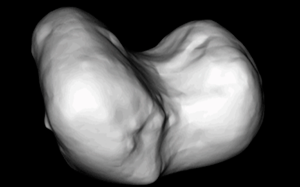
Solar storm missed this teacup — On July 23, 2012, the sun unleashed two massive clouds of plasma that barely missed a catastrophic encounter with the Earth’s atmosphere. These plasma clouds, known as coronal mass ejections (CMEs), comprised a solar storm thought to be the most powerful in at least 150 years. “If it had hit, we would still be picking up the pieces,” physicist Daniel Baker of the University of Colorado tells NASA. Fortunately, the blast site of the CMEs was not directed at Earth. Had this event occurred a week earlier when the point of eruption was Earth-facing, a potentially disastrous outcome would have unfolded.
It probably would have caused widespread power blackouts, disabling everything that plugs into a wall socket.
~ We can achieve all that ourselves, of course, with wars.
Closer look at a visiting asteroid — Last week, as the Rosetta spacecraft came within 1400 kilometres of its destination comet, Comet 67P/Churyumov–Gerasimenko, which it’s supposed to land on! It sent back images of what appeared to be a whirling rubber ducky in space. Now, using the same data, researchers have created a 3D model of the object (above).
~ Good luck with that landing.
A Terabyte in a tablespoon — Researchers from the University of Michigan and New York University demonstrated how plastic nanoparticles, deposited in a liquid, can form a one-bit cluster — and that’s the essential building block for information storage. It’s called “wet computing,” and the technique mimics other biological processes found in nature, like DNA in living cells.
~ Giving the phrase ‘data leak’ a whole new world of possibilities.

The future — I’m looking at it. Yeah, I have installed the Yosemite Beta on my MacBook Pro.
US Army to 3D print warheads — In its latest bid to kill more people, more efficiently, and at less cost, the army is planning to print warhead components, according to the latest issue of Army Technology. “3D printing of warheads will allow us to have better design control and utilize geometries and patterns that previously could not be produced or manufactured,” James Zunino, a researcher at the Armament Research, Engineering and Design Center said.
~ Doesn’t that just warm your heart?
Smart design means no glasses or contacts needed — Researchers at Berkeley, MIT, and Microsoft have developed a prototype that could one day make glasses or contacts obsolete — at least when you’re looking at your phone or computer.
~ But the frame remains the same.
Australian students break international solar car record — The Sunswift solar car team from UNSW Australia broke an international world speed record for the fastest long-range electric vehicle, averaging a speed of 107kph over 500km from a single charge with their car, eVe.
~ Outlook for them: sunny.

Retro-futurist plastic homes — In the mid-twentieth century, back when colonising the solar system seemed imminent, people decided to save money by building homes out of plastic. You can see the results here. Some are mind-bogglingly awesome, and some are just mind-boggling.
~ How many still stand? But now our house interiors are most all plastic, anyway.
Dinosaurs were really just big angry birds — A new study published in Science (abstract) suggests that most dinosaurs were covered with feathers. This conclusion was drawn after the discovery of fossils belonging to a 1.5-meter-long, two-legged dinosaur called Kulindadromeus zabaikalicus. The fossils greatly broaden the number of families of dinosaurs sporting feathers — downy, ribboned, and thin ones in this case — indicating that plumes evolved from the scales that covered earlier reptiles, probably as insulation.”
~ Why did the dinosaur cross the road? To get to the anachronism.
